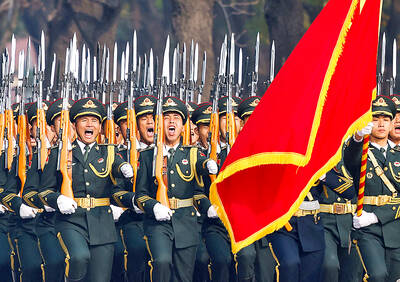More than a month after the 921 earthquake, the National Science Council (NSC) has completed a detailed map of the Chelungpu fault (
Highly anticipated by building contractors, the map of the Chelungpu fault, which has been drawn to a 1:5,000 ratio, was produced by 21 academics who have been conducting field investigations since the earthquake.
At the time of the quake, the most precise fault maps available were those of a 1:100,000 ratio, while the official one available from the Central Geological Survey (CGS) was of a 1:500,000 ratio.
"The NSC's newly produced Chelungpu fault map will be useful in considering rebuilding plans because construction prohibition zones and restricted zones can be identified by referring to it," Huang Chi-yue (
Huang said it would be easy to tell how far the fault is from damaged structures if CPA officials are making administrative maps of townships along the Chelungpu fault using the same scale as that of the NSC map.
"However, to better identify permanent prohibited zones and restricted zones along the fault, geologists have been given a tougher job -- producing a map of the same fault with a 1:1,000 ratio. This more detailed map should be completed by Dec. 15," he said.
NSC director Huang Chen-tai (
The 1:1,000 map, he added, would present the recorded geologic characters of the fault and would become an excellent reference to other thrust faults in western Taiwan.
Huang said scientists had discussed how to produce a detailed overall fault map, which would be more precise than any fault maps currently in use.
One of the challenges for contractors during rebuilding will be understanding exactly where the fault line lies. The ability to pinpoint the exact location of the fault has become a contentious point between construction engineers and scientists.
Taiwan is creased with a number of fault lines and geologists have said that it is impractical, if not impossible to map out all sections of every fault line on the island. Moreover, they say that increasing the detail of maps from 1:100,000 -- the ratio used by geologists for making scientific surveys -- to 1:1,000 in an invitation for error.
Builders argue that the more detailed maps are necessary for making blueprints that have the degree of accuracy that they are familiar with.
The builders say that maps currently available do not have nearly enough detail to allow them to know with certainty if they are building the specified distance away from an active fault line.
Scientists say the priority should be producing an official fault map using a 1:25,000 ratio, a standard which has been adopted by the US, Japan and other countries.
"It's not realistic to produce precise fault maps at 1:1,000. For geologists, the difficulty is knowing exactly where the faults are, especially those deep underground," said Shih Ruey-chyuan (石瑞銓), a seismologist from National Chung Cheng University.
"Instead of relying solely on fault maps, builders should make comprehensive site inspections before they break ground on any structure," said Tsai Yi-ben (蔡義本), professor and dean of the College of Earth Sciences at National Central University.
According to one British scientist who worked in Taiwan after the quake, fault maps are an essential guide for builders.
"If detailed maps are not available at construction sites, engineers will have to deal more with local conditions," said Colin Taylor, a civil engineering professor from Bristol University.
He said that the fault maps are needed either for scientists to identify the sources and mechanism of major earthquakes or for engineers to use during construction.
Although the UK is relatively small, its geology has been studied for more than 150 years.
"The governmental British Geological Survey has produced quite detailed geological maps of the UK in various scales. The most detailed one is 1:1,000," Taylor said.
Another engineer, Dave Edge from the UK-based WS Atkins Group, an engineering consulting firm, stressed the need for accurate maps: "One cannot be sure that the law [prohibiting the building of houses closer than 15 meters from a fault line] is successful unless one knows actually where the fault lines are."

The Ministry of Foreign Affairs (MOFA) yesterday said it is closely monitoring developments in Venezuela, and would continue to cooperate with democratic allies and work together for regional and global security, stability, and prosperity. The remarks came after the US on Saturday launched a series of airstrikes in Venezuela and kidnapped Venezuelan President Nicolas Maduro, who was later flown to New York along with his wife. The pair face US charges related to drug trafficking and alleged cooperation with gangs designated as terrorist organizations. Maduro has denied the allegations. The ministry said that it is closely monitoring the political and economic situation

Conflict with Taiwan could leave China with “massive economic disruption, catastrophic military losses, significant social unrest, and devastating sanctions,” a US think tank said in a report released on Monday. The German Marshall Fund released a report titled If China Attacks Taiwan: The Consequences for China of “Minor Conflict” and “Major War” Scenarios. The report details the “massive” economic, military, social and international costs to China in the event of a minor conflict or major war with Taiwan, estimating that the Chinese People’s Liberation Army (PLA) could sustain losses of more than half of its active-duty ground forces, including 100,000 troops. Understanding Chinese

UNRELENTING: China attempted cyberattacks on Taiwan’s critical infrastructure 2.63 million times per day last year, up from 1.23 million in 2023, the NSB said China’s cyberarmy has long engaged in cyberattacks against Taiwan’s critical infrastructure, employing diverse and evolving tactics, the National Security Bureau (NSB) said yesterday, adding that cyberattacks on critical energy infrastructure last year increased 10-fold compared with the previous year. The NSB yesterday released a report titled Analysis on China’s Cyber Threats to Taiwan’s Critical Infrastructure in 2025, outlining the number of cyberattacks, major tactics and hacker groups. Taiwan’s national intelligence community identified a large number of cybersecurity incidents last year, the bureau said in a statement. China’s cyberarmy last year launched an average of 2.63 million intrusion attempts per day targeting Taiwan’s critical

‘SLICING METHOD’: In the event of a blockade, the China Coast Guard would intercept Taiwanese ships while its navy would seek to deter foreign intervention China’s military drills around Taiwan this week signaled potential strategies to cut the nation off from energy supplies and foreign military assistance, a US think tank report said. The Chinese People’s Liberation Army (PLA) conducted what it called “Justice Mission 2025” exercises from Monday to Tuesday in five maritime zones and airspace around Taiwan, calling them a warning to “Taiwanese independence” forces. In a report released on Wednesday, the Institute for the Study of War said the exercises effectively simulated blocking shipping routes to major port cities, including Kaohsiung, Keelung and Hualien. Taiwan would be highly vulnerable under such a blockade, because it